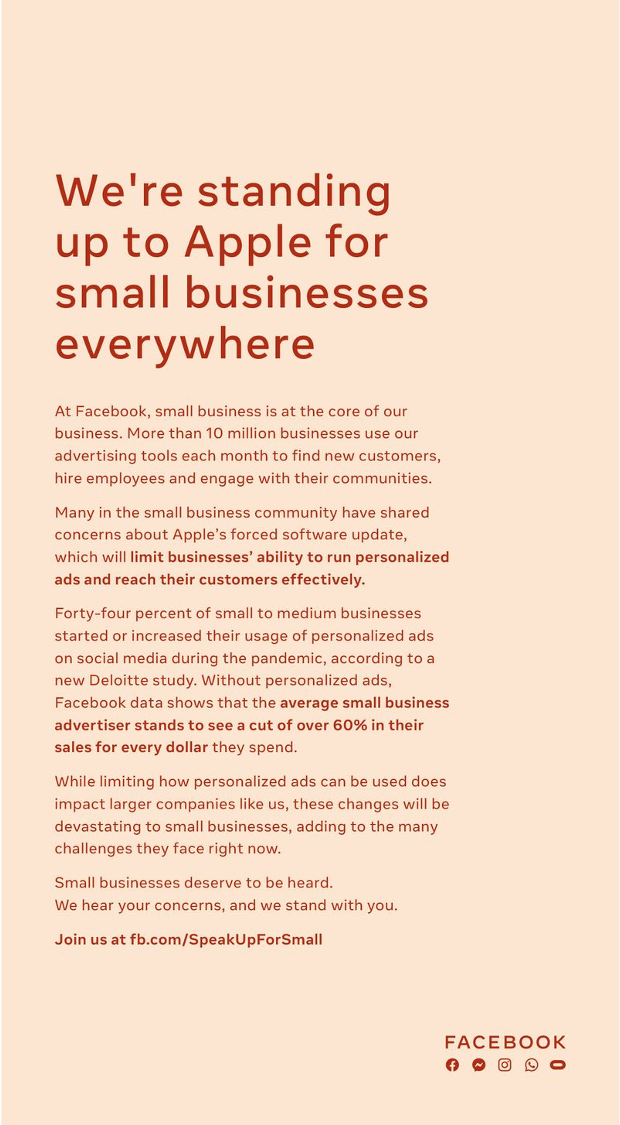The iOS14 Privacy Apocalypse Might Save Hundreds Of DTC Brands

Bhaskar Sarma
Writer

Apple’s iOS14 update, which is currently rolling out, has a number of privacy-focused features that will make it harder for apps like Facebook to collect user clickstream data across other third party apps and websites.
For bigger brands with thousands of customer personas, no tight knit community and multiple product lines, this update might hamper their ability to acquire new customers through paid social.
But these changes can level the playing field for niche and smaller DTC brands who don’t have the deep pockets needed to run increasingly expensive paid social campaigns at scale.
What exactly would the iOS14 updates mean for you if you are an eCommerce brand?
Apart from official guidance from Apple and Facebook, there are several excellent resources detailing the implications of the upcoming changes, but here is an “explain-to-me-like-I’m-five” version:
- Every iOS14 app has to explicitly ask the user’s permission before they start tracking activity across other apps and websites.
- If a user denies Facebook permission, for instance, data flowing to the Facebook pixel for that user will be severely limited.
- It will be difficult for advertisers to create high quality and large custom audiences, and impossible to get a breakdown of ad performance by parameters like age, gender, location, etc.
- Reporting data on your ad campaigns will be less accurate.
The situation is so dire that Facebook estimates it could, according to an AppleInsider report, “see a 60% drop in its income”.
That’s billions of dollars sucked out of P&L statements, and it’s no wonder Facebook is hopping mad.
It has already published full-page attack ads in newspapers castigating Apple’s supposed “anti-small business” moves and is reportedly preparing to sue Tim Cook and company.

The consumer experience with the change
On the face of it, Apple’s decision to impose these curbs is good for the customer.
At least, that’s the line Tim Cook is taking when he pitched the updates in a tweet.
While Apple’s true motives behind this move are murky, iOS14 users might be in for a ride as far as their ad experience is concerned once the rollout is complete.
What might it be like for customers and end-users? Here are some guesses:
- More irrelevant ads will flood timelines. You might be a 35-year-old woman living in the US, but Facebook will desperately want you to buy hearing aids for senior citizens from a company that ships them only in Europe.
- Apps will find sneakier, and creative ways to get you to say yes to sharing data. Some will definitely straight up try to bribe you and get banned by Apple
- A new generation of social networks- possibly built on blockchain- that rewards and incentivizes users to share their data might disrupt Facebook’s hegemony.
- You might see EVEN more ads on the first page of Google (these changes don’t impact Google- lucky them).
- Popup ads and banner ads might make a comeback as advertisers look to make up for their curtailed reach on Facebook.
- You might be hearing more ads on smart speakers, or get hit with an avalanche of direct mail.
- YouTube might be peppered with even more ads than it has now.
No matter what the final changes are, it’s clear that consumers are in for an exciting ride.
For a lot of brands, these changes will be existential, and Facebook is not exaggerating when it says many small businesses will suffer.
Paraphrasing Gary Vaynerchuk in an HBR article, these businesses include 98% of DTC brands who are out of business but don’t know it yet.
Moving your brand out of the iOS14 blast radius
There is a two-step playbook to growth in a world where paid social isn’t a guaranteed channel:
1. Diversify your customer acquisition and retention channels
Even without the iOS14 changes, you need to stop depending on Facebook: their AI systems keep on randomly shutting down ad accounts without any accountability.
Invest in channels like email, SMS, SEO, paid search, affiliate marketing, etc. Experiment with co-branded promotions. Check out newer, less crowded channels like voice, or take a deep dive into old classics like direct mail.
None of these channels will completely replace the scale and convenience of Facebook ads, but they will guarantee the resilience of your brand.
2. Invest in narrative-led brand building
I am most excited by this line item because it gives innovative brands a chance to flex their creative muscles.
In a world where nearly everything is commoditized, the quickest way to insulate your brand from obscurity is to make it a part of a story that your customers can relate to.
DTC brands are well placed to pull this off, and there are many notable examples like :
- Haus, a spirits brand founded by a millennial couple who didn’t fancy high alcohol content drinks (they grew 500% last year).
- Hint Water, a flavored water brand whose founder wanted to kick her diet soda addiction.
- OUI The People, Golde, etc that make beauty and skincare products designed for women of color.
These companies have loyal customers who proclaim their love for the brand, a unique personality, and a deep understanding of the needs of their market.
They won’t go out of business if their Facebook ad account is shut down.
Content and experience are two channels where innovative brands are pushing boundaries and earning top of the mind awareness through the power of narrative.
These channels manifest themselves in different ways:
- Owned media (Glossier grew into a DTC beauty unicorn on the back of an active blog).
- Exclusive experiences (The merch store at Augusta National Golf club open for only a week per year and is the only place in the world that sells Masters branded apparel worth millions of dollars).
- Viral product drops (MSCHF sells limited edition, random products every week that are sold out within seconds).
Influencer marketing is another content-based channel that relies on storytelling and is set to be worth $15billion by 2022.
Reimagining eCommerce customer experience around stories
If you really want to understand the impact of storytelling in eCommerce, look no further than China.
In 2020, Chinese eCommerce live streamers sold an estimated $60bn worth of merchandise, and around 560 million people viewed these streams.
These live streamers are household celebrities, and they can sell so much because they make shopping fun.
They have built a personal rapport with their fans, to the extent that one brings his dog to his live stream (the dog is also a celebrity in Chinese social media).
So how do you, an eCommerce brand, win at storytelling?
Get the basics right first. Build out a brand story, and keep it consistent across mediums.
For instance, your product description page should read the same as your Instagram captions and your emails (use a product information management solution as the single source of truth for your product story, even if you have a fast-changing inventory with tens of thousands of products).
Then, start using content creatively to stake out a position consistent with your brand voice, and differentiate yourself from your competitors.
Start delivering remarkable customer experience across all touchpoints, and watch your revenues and profits grow.
Adopt this playbook and you will never be beholden to massive corporations and capricious algorithms.
We believe users should have the choice over the data that is being collected about them and how it’s used. Facebook can continue to track users across apps and websites as before, App Tracking Transparency in iOS 14 will just require that they ask for your permission first. pic.twitter.com/UnnAONZ61I
— Tim Cook (@tim_cook) December 17, 2020
This happens way too often. https://t.co/FvBZAg6uM6
— Ad Elixir (@AdElixir) November 27, 2020
Facebook has said again and again that small businesses are relying on them to get through covid. That’s true, and also devastating when these small businesses get their ad accounts mistakenly banned ahead of the most important shopping season. https://t.co/qfznV7zEHU
— Sarah Frier (@sarahfrier) November 27, 2020
